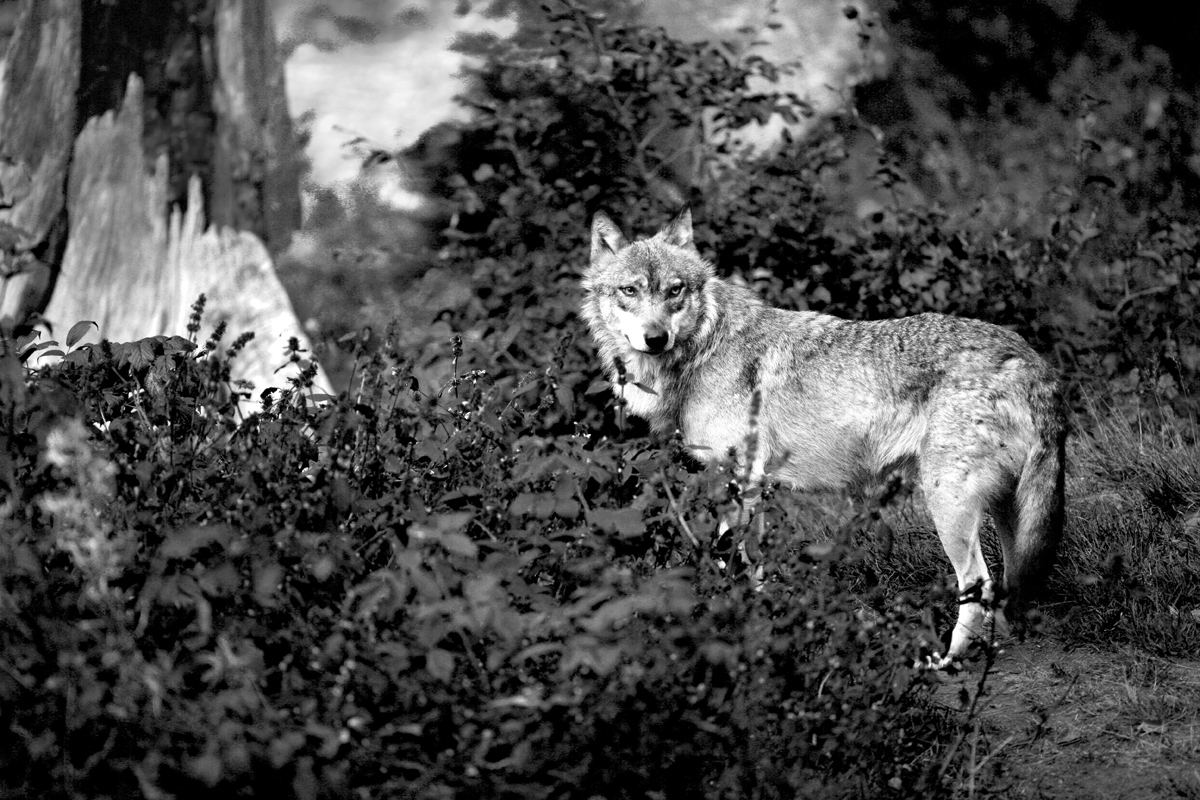The Local newsletter is your free, daily guide to life in Colorado. For locals, by locals.
One night in Colorado’s South Park Valley in the 1840s, a British adventurer named George Frederick Ruxton awoke next to his campfire to find a wolf a few feet away. The creature sat near the flames, “his eyes closed, and his head nodding in sheer drowsiness,” Ruxton wrote in his memoir, Wild Life in the Rocky Mountains. “I had never seen or heard of one approaching so close as to warm his body, and for that purpose alone…. I looked at him for some moments without disturbing the beast, and closed my eyes and went to sleep, leaving him to the quiet enjoyment of the blaze.”
At the time, wolves were “so common on the plains and in the mountains,” according to Ruxton, “that the hunter never cares to throw away a charge of ammunition upon them.” One day, riding horseback in the Sangre de Cristo Mountains, Ruxton discovered a wolf had been following his progress for several days and noted that the animal “became such an old friend that I never dreamed of molesting him.”
In the many decades since Ruxton traveled through Colorado, however, our relationship with the gray wolf (also known as the timber wolf) has changed dramatically. This year marks an unfortunate anniversary for wolves in the Centennial State: 70 years ago, the last wild wolf born in the Western United States in the first half of the 20th century was killed somewhere in Conejos County, in the southern reaches of the San Juan Mountains.
During the past several years, there have been signs of a return of the gray wolf to Colorado. Reintroduced to Wyoming and Idaho in the 1990s by the U.S. Fish and Wildlife Service, wolves have thrived in the Northern Rockies. A few have even dispersed south in failed attempts to colonize new ground. A female wolf was killed by a car on I-70 near Idaho Springs in June 2004; in March 2006, there were several sightings of a wolf in North Park near Walden (the sightings were later confirmed by a Colorado Division of Wildlife video, but the animal was never seen again); and in April 2009, a wolf was found poisoned to death in Rio Blanco County.
But despite protections under the Endangered Species Act (ESA) that bar citizens from killing wolves in Colorado, Canis lupus has not fared well in the Centennial State—and those ESA protections could end this year, further threatening the wild wolves. Wolves have already been delisted in parts of the Northern Rockies (Montana and Idaho) where populations are considered healthy. And now the U.S. Fish and Wildlife Service is considering a proposal to remove the gray wolf from the endangered species list in every state in the Lower 48.
The delisting proposal, on which the wildlife agency is expected to release a final recommendation this fall, has prompted a debate among biologists over whether wolves would survive the onslaught of hunting that a national delisting could unleash. “Many conservation biologists would say the wolf is still not recovered, biologically, ecologically, or legally, under the [Endangered Species Act],” says Bradley Bergstrom, an ecologist and biology professor at Valdosta State University in Georgia who has studied conservation biology and policy relating to carnivores in the West. The areas where breeding populations are currently established, in parts of Montana, Wyoming, Idaho, Washington, and Oregon, says Bergstrom, “are only a fraction of the area of suitable habitat within the gray wolf’s historic range.”
The death of the last Colorado wolf 70 years ago marked the end of a long, brutal campaign to extirpate the gray wolf in the state. In 1869, Colorado was the first state in the Rockies to offer bounties on wolves, in part because Colorado had a developed network of railroads from which commercial hunters operated. The railroads also facilitated the organization of the livestock industry, which banded together under the nation’s first statewide cattlemen’s group, the Colorado Stockgrowers Association, in 1867. Cattlemen disliked wolves because they preyed on cows and sheep. Settlement of the land by white pioneers had decimated the wolves’ native food supply—mule deer, elk, and bighorn sheep—so the predators had turned to the animals that were easiest to take for a meal.
Seventy-five years after Ruxton slept peacefully beside a wolf in the firelight, Colorado was at the forefront of wolf killing in the West. At the behest of the state’s powerful livestock lobby, the federal government organized an army of poisoners and trappers, operating under the purview of the U.S. Bureau of Biological Survey, to hunt wolves. “From 1915 onward, as in most Western states, the livestock-industry-friendly Legislature in Colorado appropriated ample matching funds for the federal efforts,” says Michael Robinson, a conservationist with the Center for Biological Diversity and author of Predatory Bureaucracy: The Extermination of Wolves and Transformation of the West, an exhaustive history of wolf extermination in Colorado and across the West.
By 1923, as Robinson documents, Stanley Young, chief of the Colorado branch of the Biological Survey, felt confident enough to announce to the state’s stockmen at their annual convention that the hunters had located “every wolf pack in Colorado, and it is just a question of time as to when we will be able to get around to your place to eradicate them.”
The Rocky Mountain News ran a series of articles in the early 1920s that lionized Young’s crew of hunters as “grim” and “sun-bronzed,” pursuing an “animal criminal” whose “cruel, rapacious devastations give him no place in modern civilization.” In Colorado, an article in the paper suggested, the gray wolf was “making his last stand against humanity.”
The last stand was a drama to behold. The Biological Survey hunters, vying to claim the most kills, named the wolves that were the finest at outsmarting them. There was Unaweep, a female who roamed near Unaweep Canyon south of Grand Junction; Old Whitey, a majestic white male often seen on Bear Springs Mesa near Thatcher; and Three-Toes, a female mate of Old Whitey who had escaped a trap but lost a toe on her hind foot. Three-Toes eventually became the most hated wolf in Colorado because she was the most slippery. By 1921 a Biological Survey hunter had trapped and killed Old Whitey. Three-Toes, undeterred, went on to seduce a ranch dog who was supposed to have been protecting cattle, and the pair had a litter of wolf-dog hybrids in the spring of 1923. Hunters quickly killed the young creatures.
When trapper Roy Spangler finally caught Three-Toes in a trap on June 11, 1923, the wolf fled, dragging the trap hook for miles. Spangler pursued the wolf, despite the fact that his wife had fallen sick from smallpox and lay suffering in their cabin. Spangler eventually caught up with Three-Toes and brought the trophy home to his wife, who had died.
The Colorado wolf packs were poisoned, shot, and trapped, and by 1945 only a single wolf remained. By 1978, when the federal government declared all subspecies of gray wolves endangered, the extermination program had metastasized to include every state where wolves had once ranged west of the Mississippi.
The Biological Survey later became known as Wildlife Services, a branch of the U.S. Department of Agriculture, and Wildlife Services still exists today—and still has the authority to kill wolves at the behest of ranchers in states where the animal has been delisted.
This past November, a female wolf made national headlines as it journeyed 750 miles from Wyoming, perhaps through Colorado, to the Kaibab Plateau in northern Arizona, on the north rim of the Grand Canyon. Wildlife ecologists considered it a sign of hope for the recovery of the West’s iconic predator. I traveled to the Kaibab Plateau in November to look for the wolf, whom schoolchildren had christened Echo in a naming contest. I camped under the starlight and one night heard her howl in the pines at dusk.
A few weeks later, Echo was killed. The wolf was apparently shot to death in southern Utah by a hunter who had mistaken her for a coyote. The U.S. Fish and Wildlife Service’s law enforcement division was, at press time, investigating the incident as a possible crime because it is still illegal for citizens to kill wolves in all Western states except for Montana and Idaho.
If the U.S. Fish and Wildlife Service removes the wolf from the ESA, however, that will change. In a way, delisting the wolf could return Colorado and the rest of the country to the days of Stanley Young and Roy Spangler—a time when wolves were shot on sight and targeted with poisons. “The Endangered Species Act,” Robinson says, “prevents resumption of an all-out, century-old, taxpayer-funded war fueled by a pre-ecological wolf hatred.” Policymakers would do well to remember the account of George Ruxton, sleeping next to that wolf by the fire.









